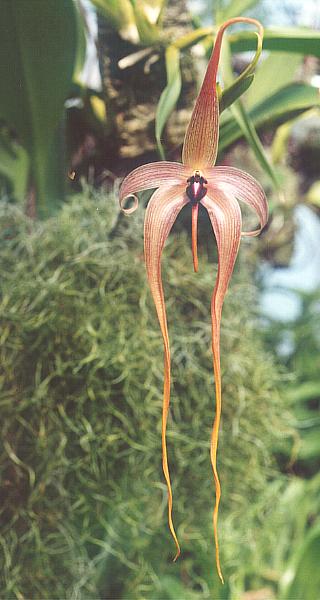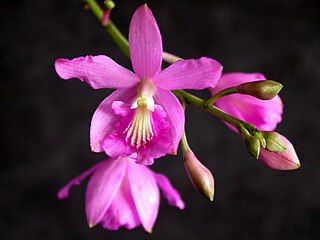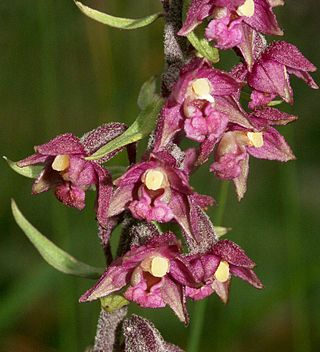
Orchids are plants that belong to the family Orchidaceae, a diverse and widespread group of flowering plants with blooms that are often colourful and fragrant. Orchids are cosmopolitan plants that are found in almost every habitat on Earth except glaciers. The world's richest diversity of orchid genera and species is found in the tropics.

Bulbophyllum is a genus of mostly epiphytic and lithophytic orchids in the family Orchidaceae. It is the largest genus in the orchid family and one of the largest genera of flowering plants with more than 2,000 species, exceeded in number only by Astragalus. These orchids are found in diverse habitats throughout most of the warmer parts of the world including Africa, southern Asia, Latin America, the West Indies, and various islands in the Indian and Pacific Oceans. Orchids in this genus have thread-like or fibrous roots that creep over the surface of trees or rocks or hang from branches. The stem is divided into a rhizome and a pseudobulb, a feature that distinguished this genus from Dendrobium. There is usually only a single leaf at the top of the pseudobulb and from one to many flowers are arranged along an unbranched flowering stem that arises from the base of the pseudobulb. Several attempts have been made to separate Bulbophyllum into smaller genera, but most have not been accepted by the World Checklist of Selected Plant Families.

Cymbidium, commonly known as boat orchids, is a genus of evergreen flowering plants in the orchid family Orchidaceae. Orchids in this genus are epiphytic, lithophytic, terrestrial or rarely leafless saprophytic herbs usually with pseudobulbs. There are usually between three and twelve leaves arranged in two ranks on each pseudobulb or shoot and lasting for several years. From one to a large number of flowers are arranged on an unbranched flowering stem arising from the base of the pseudobulb. The sepals and petals are all free from and similar to each other. The labellum is significantly different from the other petals and the sepals and has three lobes. There are about fifty-five species and sixteen further natural hybrids occurring in the wild from tropical and subtropical Asia to Australia. Cymbidiums are well known in horticulture and many cultivars have been developed. The genome of Cymbidium mannii has been sequenced to study epiphytism and crassulacean acid metabolism.

Cattleya is a genus of orchids from Costa Rica south to Argentina. The genus is abbreviated C in trade journals.

Laelia is a small genus of 25 species in the orchid family (Orchidaceae). Laelia species are found in areas of subtropical or temperate climate in Central and South America, but mostly in Mexico. Laelia is abbreviated L. in the horticultural trade.

Epidendrum, abbreviated Epi in the horticultural trade, is a large neotropical genus of the orchid family. With more than 1,500 species, some authors describe it as a mega-genus. The genus name refers to its epiphytic growth habit.

Encyclia is a genus of orchids. The genus name comes from Greek enkykleomai, referring to the lateral lobes of the lip which encircle the column. It is abbreviated as E. in the horticultural trade.

Pseudolaelia is a small genus belonging to the orchid family (Orchidaceae), the entire genus endemic to Brazil. The abbreviation used in the horticultural trade is Pdla.

Epipactis atrorubens, the dark-red helleborine or royal helleborine, is an herbaceous plant in the orchid family, Orchidaceae.

Cattleya trianae, also known as Flor de Mayo or "Christmas orchid", is a plant of the family Orchidaceae. It grows as an epiphytic orchid, with succulent leaves, endemic to Colombia where it was nominated as the national flower in November 1936. That year, the National Academy of History of Argentina asked the Latin American countries to participate in an exhibition with the representative flowers of each country. The Colombian government gave the botanist Emilio Robledo the task to designate the most representative flowering plant of the country.

Rhynchostylis is a genus in the orchid family (Orchidaceae), closely allied to the genus Vanda and comprising four currently accepted species native to the Indian Subcontinent, China, Indochina, Malaysia, Indonesia and the Philippines.

Bifrenaria, abbreviated Bif. in horticultural trade, is a genus of plants in family Orchidaceae. It contains 20 species found in Panama, Trinidad and South America. There are no known uses for them, but their abundant, and at first glance artificial, flowers, make them favorites of orchid growers.

Cattleya aclandiae, or Lady Ackland's cattleya, is a species of orchid from the genus Cattleya, named in honor of Lady Lydia Elizabeth Ackland, wife of Sir Thomas Dyke Acland, 10th Baronet who was the first European to grow the plant successfully. The illustration of the plant which accompanied its first description was based on a drawing by Lady Ackland. The genus was named in honour of William Cattley, a prominent British merchant and horticulturist.

Cattleya maxima is a species of orchid in subfamily Epidendroideae found from Ecuador to Peru.

Cattleya walkeriana, or Walker's cattleya, is a species of orchid. It differs from most species of Cattleya by having inflorescences which arise from the rhizome instead of from the apex of the pseudobulb. In its native habitat it grows as either an epiphyte or a lithophyte, sometimes in full sun, at elevations up to 2000 meters. Pseudobulbs are relatively short, bulbous or fusiform, with one or two ovate leaves at the apex. Inflorescence is one- or few-flowered, about 8" (20 cm) tall. Flowers are 4-5" (9-12 cm) across.

Cattleya warscewiczii, a labiate Cattleya, is a species of orchid.

Isabelia is an orchid genus formed by three tiny species and one natural hybrid, spread from the Northeast of Brazil to Argentina, which are closely related to the genus Constantia. During more than a century Isabelia was a genus formed by just one species, however, around 1968, it was merged with genus Neolauchea, also unispecific. In 2001, a third genus was added to it, Sophronitella. The genus name is abbreviated Isa. in cultivation.

Cattleya cernua, commonly known as the nodding sophronitis, is a species of orchid occurring from Brazil to northeastern Argentina. It was the type species of the genus Sophronitis until the genus was made synonymous with Cattleya. Twenty plants of C. cernua have received a total of 22 AOS awards. The described flowers range from 1.9 cm to 3.2 cm horizontal spread and from 2.0 cm to 3.0 cm vertical spread.

Cattleya rex is a species of epiphytic orchid of showy white flowers, native to montane forests in Peru and Bolivia.

Broughtonia sanguinea, also known as blood red broughtonia is a plant in the genus Broughtonia, a member of the family Orchidaceae. It was named in 1813 by its first describer, Robert Brown, for 18th century English botanist Arthur Broughton.





















